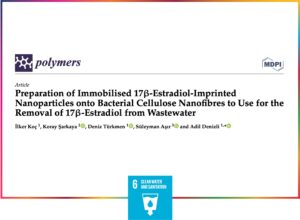
Water contamination by endocrine-disrupting chemicals (EDCs) poses a significant threat to both human health and the environment. In response, researchers, including a scientist from Near East University, have pioneered an innovative method for the selective removal of a prominent EDC, 17β-estradiol (E2), from wastewater.
In this study, the team designed 17β-estradiol-imprinted nanoparticles using hydroxyethyl methacrylate (HEMA) and applied them onto bacterial cellulose nanofibers (E2-NP/BC-NFs). Rigorous characterizations, including FT-IR, NMR, BET, SEM, µCT, contact angle, and swelling tests, confirmed the structural integrity and functionality of the composite.
Adsorption studies were conducted in batch mode under various conditions, optimizing parameters for efficiency. The results indicated a maximum E2 adsorption of 254 µg/g in phosphate buffer at 45 °C. Langmuir and pseudo-second-order kinetic models accurately described the adsorption process, reaching equilibrium in under 20 minutes. The researchers also assessed the material’s selectivity using competing steroids, demonstrating that E2-NP/BC-NFs exhibit remarkable selectivity—46.0 times more than cholesterol and 21.0 times more than stigmasterol.
Importantly, the study evaluated the reusability of the synthesized composite, demonstrating consistent adsorption capacity over ten cycles. This finding highlights the sustainability of the developed method for continuous water purification.
E2, known for its low water solubility, presents challenges in conventional wastewater treatment. The newly developed substance, E2-NP/BC-NFs, acts as an effective adsorbent, enhancing E2 removal from wastewater. Affinity nanofibers, blending high efficiency with a particular molecule’s affinity and high selectivity, offer a durable alternative for tackling EDC contamination.
By developing this advanced water purification method, Near East University researchers contribute to achieving Sustainable Development Goal 6 (Clean Water and Sanitation). The study underscores the importance of nanotechnology in crafting efficient adsorbents, paving the way for sustainable solutions to water pollution challenges.
More Information:
https://www.mdpi.com/2073-4360/15/5/1201